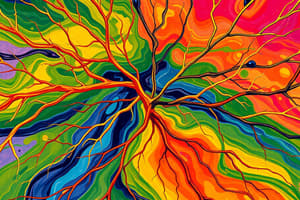Podcast
Questions and Answers
What is the primary role of the sensory (afferent) division of the peripheral nervous system?
What is the primary role of the sensory (afferent) division of the peripheral nervous system?
- To perceive sensations from the environment.
- To send signals from the brain to the muscles.
- To transmit action potentials from sensory receptors to the central nervous system. (correct)
- To regulate the dilation of blood vessels.
What is meant by 'efferent' in the context of the motor division of the peripheral nervous system?
What is meant by 'efferent' in the context of the motor division of the peripheral nervous system?
- Regulating the internal functions of the body.
- Sending signals towards the sensory receptors.
- Transmitting sensory information to the brain.
- Conducting signals from the central nervous system to effector organs. (correct)
Which of the following actions is primarily controlled by the motor (efferent) division?
Which of the following actions is primarily controlled by the motor (efferent) division?
- Dilating blood vessels.
- Sending sensory information to the CNS.
- Perceiving temperature changes.
- Sweating in response to heat. (correct)
What happens when sensory neurons detect heat from the environment?
What happens when sensory neurons detect heat from the environment?
Why is it important for blood vessels to dilate when it is hot outside?
Why is it important for blood vessels to dilate when it is hot outside?
Which of the following correctly defines afferent neurons?
Which of the following correctly defines afferent neurons?
What triggers the sweating response in the body when it is hot?
What triggers the sweating response in the body when it is hot?
In the context of the nervous system, what does 'action potential' refer to?
In the context of the nervous system, what does 'action potential' refer to?
What initiates the depolarization of the cell?
What initiates the depolarization of the cell?
What happens to the voltage-gated sodium channels during the depolarization phase?
What happens to the voltage-gated sodium channels during the depolarization phase?
What is the effect of Sodium ions entering the cell during depolarization?
What is the effect of Sodium ions entering the cell during depolarization?
What characterizes the 'all or none law' in terms of action potential?
What characterizes the 'all or none law' in terms of action potential?
Why might the cell not reach depolarization with insufficient stimulus?
Why might the cell not reach depolarization with insufficient stimulus?
How do potassium-voltage-gated channels behave during the early stages of depolarization?
How do potassium-voltage-gated channels behave during the early stages of depolarization?
What occurs when the inside of the cell becomes more positive than the outside?
What occurs when the inside of the cell becomes more positive than the outside?
What role does the sodium-potassium pump play during depolarization?
What role does the sodium-potassium pump play during depolarization?
What process allows action potentials to jump from one node to another along myelinated axons?
What process allows action potentials to jump from one node to another along myelinated axons?
What is the result of the influx of calcium ions at the presynaptic terminal?
What is the result of the influx of calcium ions at the presynaptic terminal?
Why is less energy required for the sodium-potassium pump in myelinated axons compared to unmyelinated axons?
Why is less energy required for the sodium-potassium pump in myelinated axons compared to unmyelinated axons?
Which of the following best defines the term 'cleft' as used in synaptic transmission?
Which of the following best defines the term 'cleft' as used in synaptic transmission?
What mechanism do neurotransmitters use to cross the synaptic cleft?
What mechanism do neurotransmitters use to cross the synaptic cleft?
What is the primary function of the sodium-potassium pump in neurons?
What is the primary function of the sodium-potassium pump in neurons?
How do neurotransmitters interact with their receptors on the postsynaptic neuron?
How do neurotransmitters interact with their receptors on the postsynaptic neuron?
Which channels are specifically mentioned as being ligand-gated on the postsynaptic neuron?
Which channels are specifically mentioned as being ligand-gated on the postsynaptic neuron?
What is the primary role of acetylcholine in the nervous system?
What is the primary role of acetylcholine in the nervous system?
What is one mechanism by which norepinephrine is cleared from the synaptic cleft?
What is one mechanism by which norepinephrine is cleared from the synaptic cleft?
How does enzymatic degradation affect neurotransmitter function?
How does enzymatic degradation affect neurotransmitter function?
What defines a reflex arc in the nervous system?
What defines a reflex arc in the nervous system?
Why is the mechanism of neurotransmitter transfer described as occurring 'countless times per second'?
Why is the mechanism of neurotransmitter transfer described as occurring 'countless times per second'?
What is the effect of a converging neuronal pathway?
What is the effect of a converging neuronal pathway?
What could happen if acetylcholine is not effectively broken down in the synapse?
What could happen if acetylcholine is not effectively broken down in the synapse?
Which statement accurately describes the reaction duration of synaptic neurotransmitter action?
Which statement accurately describes the reaction duration of synaptic neurotransmitter action?
What initiates a reflex action without input from the brain?
What initiates a reflex action without input from the brain?
Which branch of the sensory neuron carries an action potential to the brain?
Which branch of the sensory neuron carries an action potential to the brain?
What is formed when the dorsal and ventral roots join together?
What is formed when the dorsal and ventral roots join together?
What type of neuron is described as pseudounipolar?
What type of neuron is described as pseudounipolar?
What is the main role of the interneurons in the reflex arc?
What is the main role of the interneurons in the reflex arc?
How does a reflex action differ from a voluntary movement?
How does a reflex action differ from a voluntary movement?
What is a likely consequence of damage to spinal nerves?
What is a likely consequence of damage to spinal nerves?
What type of communication occurs when signals from the cerebral cortex reach motor neurons?
What type of communication occurs when signals from the cerebral cortex reach motor neurons?
Study Notes
Peripheral Nervous System Divisions
- The sensory division is also known as the afferent division.
- The afferent division carries signals from sensory receptors to the central nervous system.
- The motor division is also known as the efferent division.
- The efferent division carries signals from the central nervous system to effector organs.
- Sensory neurons transmit action potentials from the periphery to the CNS.
- Motor neurons transmit action potentials from the CNS to effector organs.
Action Potential
- During an action potential, sodium channels open allowing sodium ions to enter the cell.
- This makes the inside of the cell more positive than the outside.
- When the cell reaches a certain threshold, the sodium channels close and potassium channels open.
- Potassium ions leave the cell, making the inside more negative again.
- This process is called repolarization.
- The all or none law states that a stimulus must reach a certain threshold to trigger an action potential.
Myelinated Axons
- The myelin sheath is a fatty substance that covers some axons.
- Myelination increases the speed of action potential conduction.
- Action potentials jump from one node of Ranvier to the next, a process called saltatory conduction.
- Myelinated axons require less energy than unmyelinated axons because the sodium-potassium pump is only active at the nodes of Ranvier.
Synaptic Transmission
- Synaptic vesicles contain neurotransmitters which are released into the synaptic cleft.
- Neurotransmitters bind to receptor molecules on the postsynaptic neuron.
- Acetylcholine is a common neurotransmitter.
- Acetylcholinesterase is the enzyme that breaks down acetylcholine.
- Norepinephrine is another common neurotransmitter.
Reflexes
- A reflex is an involuntary response to a stimulus.
- The reflex arc is the neural pathway that mediates a reflex.
- Reflexes do not require conscious thought.
- Converging neuronal pathways allow multiple neurons to synapse with the same postsynaptic neuron.
Spinal Nerves
- Spinal nerves connect the spinal cord to the periphery
- Spinal nerves are formed by the fusion of ventral and dorsal roots.
- The dorsal root ganglion contains the cell bodies of sensory neurons.
- Pseudounipolar neurons have a peripheral branch and an ascending branch.
Studying That Suits You
Use AI to generate personalized quizzes and flashcards to suit your learning preferences.
Related Documents
Description
Explore the divisions of the peripheral nervous system, including the sensory and motor divisions, and their roles in signal transmission. Learn about action potentials, their phases, and the mechanisms of depolarization and repolarization in neurons.




